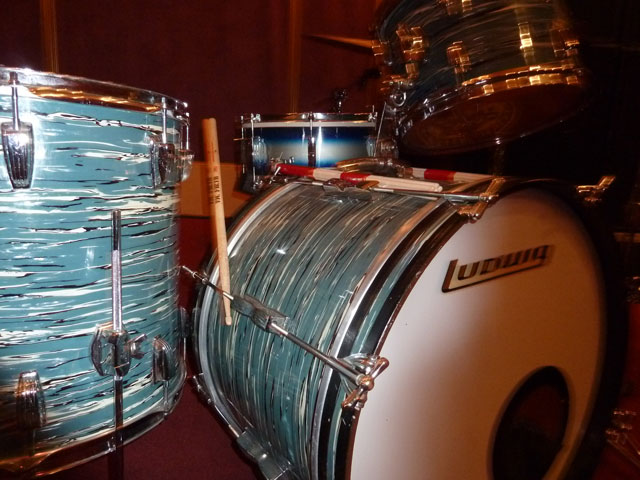Take Your Drum Loops to the Next Level: Seamless Loop Transitions
Table of Contents
Introduction
We all know what real drums sound like when played – they ring, they rattle, they vibrate. Unlike many other instruments, drum kits are a collection of  distinct sounds. There’s the low thump of the kick, the crack of the snare, the punchy tones of toms, and the high-end sizzle of cymbals.
distinct sounds. There’s the low thump of the kick, the crack of the snare, the punchy tones of toms, and the high-end sizzle of cymbals.
And, for as disparate as these drum and cymbal voices may be, we need to think of the drum kit as a cohesive unit and not merely an assembly of different rhythmic instruments.
It’s with this concept in mind that we take a look today at the crucial role that transitions between loops play in creating a lifelike, authentic drum track.
The Reality of Tracking Drums (A Whole Lot of Sound Going On!)
One of the surest ways to create realistic drum tracks using drum loops is to pay close attention to the transitions between loops. An obvious giveaway of the “Oh, those are drum loops” type drum track is an unnatural cut-off of the natural decay of live drums and/or cymbals. When a drummer comes out of a section using the ride or crash cymbal into one that features the hihat, that ride or crash will continue ringing – it certainly doesn’t stop cold when the transition occurs. That decay of the cymbals from one section to the next is a subtle but powerful reminder that the drumming is from a single take.
The same situation can be found coming out of a drum roll. As the drummer flies down the various toms before returning to the groove, that drum roll is still resonating into the next bar. It may be only for a few beats but it’s there, whether you realize it or not. In fact, it’s when that resonance, ring, or decay is NOT there that listeners become aware that something is off, something is not quite right or as might be expected.
In short, it sounds unnatural.
Using the Pieces to Create the Whole (seamless drum track, that is)
One of the defining features of all Beta Monkey drum loop libraries is the inclusion of a matching set of drum samples taken from the same recording session as the loops. It’s a feature users have always thanked us for and one we feel we pioneered some 15+ years ago. Some loop packs include a smattering of hits – we give you a fully-sampled kit. Somehow we knew they would be crucial to constructing realistic drum tracks from these 1,2, or 4 bar units we know as “loops.”
While there are other benefits (sequencing the samples in a virtual instrument or augmenting existing live loops), one of the most crucial is in allowing users to create seamless transitions between any disparate loops (ones using different elements of the drum kit).
One Video and One Trick to Create Better Drum Tracks
In this video tutorial, we will show you step-by-step how to get more realistic drum tracks from your Beta Monkey drum loops and samples when you use the included single hit drum samples included with every loop library.
This video uses our Drum Werks IX rock drum loops and demonstrates how to use single hit samples to make transitions between loops more natural and authentic. It’s not at all a difficult process and this video will explain it in just a a minute or so. Regardless of the DAW you use, the process is essentially similar: it involves importing single hit sounds onto new tracks in your project, strategically placing them to create a bridge between loops (generally going into different sections of a song).
Watch the video and learn how to create these seamless transitions.
Conclusion
The key to creating seamless loop transition truly lies in having individual drum and cymbals samples. Having the discreet, individual sounds of the drum-kit allow for the right amount of augmentation or blending to make sure any of the sounds present in the looped drum track from being cut off unnaturally. Surprisingly, many loop and sample makers don’t give you the option. They simply do not include any of the drums or cymbals from the recording session or, if they do, it is too sparse to really have any options for natural and realistic blending.
Fortunately, when we began recording our loop packs, we always thought to grab multiple single hits from every cymbal and drum we were recording. Even in the earliest releases, our selection of drum samples from the recording sessions were more than sufficient for sound-blending purposes. And, today, those sample sections found on every Beta Monkey release are even more comprehensive! In fact, many customers will purchase our libraries for the samples alone and use them for feeding into various different virtual instruments. Essentially, they create the drum parts they are after with the samples and will use the include fills or one-shots for when the sequencing doesn’t sound natural enough.
The point is, we give you a comprehensive drum sample pack on every loop product we sell. Not many other sample content producers do that, even if many have tried to copy our idea when we introduced it in 2001!
So, in closing, have fun as you build natural drum tracks quickly and easily with Beta Monkey drum loops.
Just remember to use the single hits to make those transitions seamless!
